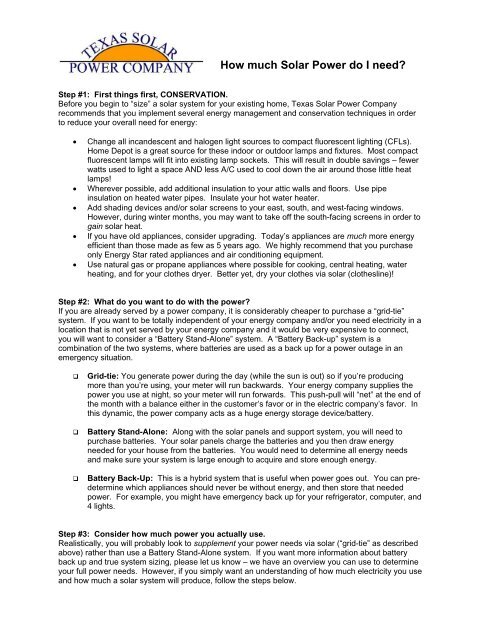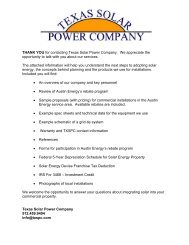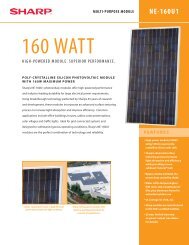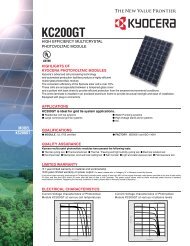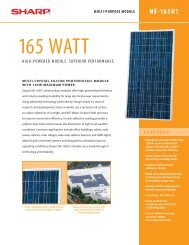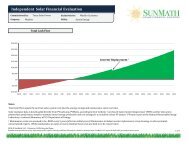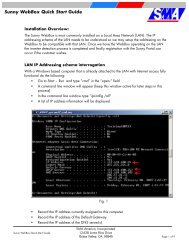Austin Energy - Texas Solar Power Company
Austin Energy - Texas Solar Power Company
Austin Energy - Texas Solar Power Company
You also want an ePaper? Increase the reach of your titles
YUMPU automatically turns print PDFs into web optimized ePapers that Google loves.
How much <strong>Solar</strong> <strong>Power</strong> do I need?<br />
Step #1: First things first, CONSERVATION.<br />
Before you begin to “size” a solar system for your existing home, <strong>Texas</strong> <strong>Solar</strong> <strong>Power</strong> <strong>Company</strong><br />
recommends that you implement several energy management and conservation techniques in order<br />
to reduce your overall need for energy:<br />
• Change all incandescent and halogen light sources to compact fluorescent lighting (CFLs).<br />
Home Depot is a great source for these indoor or outdoor lamps and fixtures. Most compact<br />
fluorescent lamps will fit into existing lamp sockets. This will result in double savings – fewer<br />
watts used to light a space AND less A/C used to cool down the air around those little heat<br />
lamps!<br />
• Wherever possible, add additional insulation to your attic walls and floors. Use pipe<br />
insulation on heated water pipes. Insulate your hot water heater.<br />
• Add shading devices and/or solar screens to your east, south, and west-facing windows.<br />
However, during winter months, you may want to take off the south-facing screens in order to<br />
gain solar heat.<br />
• If you have old appliances, consider upgrading. Today’s appliances are much more energy<br />
efficient than those made as few as 5 years ago. We highly recommend that you purchase<br />
only <strong>Energy</strong> Star rated appliances and air conditioning equipment.<br />
• Use natural gas or propane appliances where possible for cooking, central heating, water<br />
heating, and for your clothes dryer. Better yet, dry your clothes via solar (clothesline)!<br />
Step #2: What do you want to do with the power?<br />
If you are already served by a power company, it is considerably cheaper to purchase a “grid-tie”<br />
system. If you want to be totally independent of your energy company and/or you need electricity in a<br />
location that is not yet served by your energy company and it would be very expensive to connect,<br />
you will want to consider a “Battery Stand-Alone” system. A “Battery Back-up” system is a<br />
combination of the two systems, where batteries are used as a back up for a power outage in an<br />
emergency situation.<br />
<br />
<br />
<br />
Grid-tie: You generate power during the day (while the sun is out) so if you’re producing<br />
more than you’re using, your meter will run backwards. Your energy company supplies the<br />
power you use at night, so your meter will run forwards. This push-pull will “net” at the end of<br />
the month with a balance either in the customer’s favor or in the electric company’s favor. In<br />
this dynamic, the power company acts as a huge energy storage device/battery.<br />
Battery Stand-Alone: Along with the solar panels and support system, you will need to<br />
purchase batteries. Your solar panels charge the batteries and you then draw energy<br />
needed for your house from the batteries. You would need to determine all energy needs<br />
and make sure your system is large enough to acquire and store enough energy.<br />
Battery Back-Up: This is a hybrid system that is useful when power goes out. You can predetermine<br />
which appliances should never be without energy, and then store that needed<br />
power. For example, you might have emergency back up for your refrigerator, computer, and<br />
4 lights.<br />
Step #3: Consider how much power you actually use.<br />
Realistically, you will probably look to supplement your power needs via solar (“grid-tie” as described<br />
above) rather than use a Battery Stand-Alone system. If you want more information about battery<br />
back up and true system sizing, please let us know – we have an overview you can use to determine<br />
your full power needs. However, if you simply want an understanding of how much electricity you use<br />
and how much a solar system will produce, follow the steps below.


